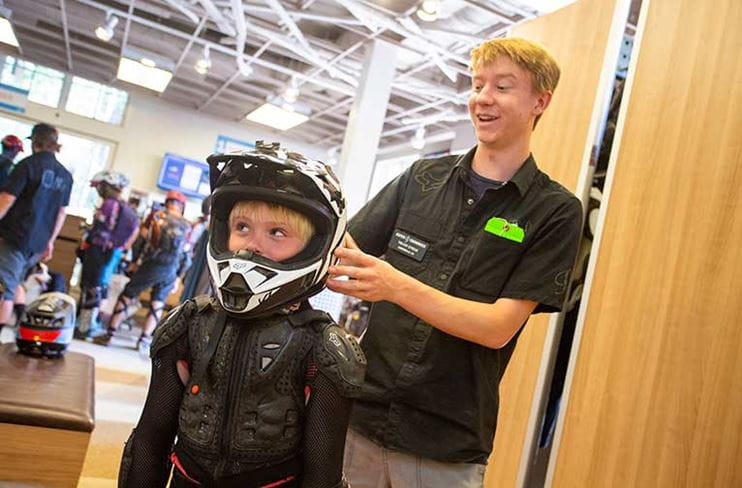
Bike Safety in the Snowmass Bike Park

Don’t be afraid to call it once you feel fatigued. Injuries and crashes are more likely when you’re hanging on for dear life on the last descent of the day.
Updated 2024
The Gear
A helmet is a must. Non-negotiable. Full-face protection is best, but a half-shell is okay too, if you’re just lightly cruising and keeping it under the speed limit.
It gets hot and dusty up on the hill, so an athletic shirt (no cotton!) will keep you cool. However, thicker pants are best to help prevent scratches from falling or nicks from the pedals.
Knee pads and gloves are essential. Your hands are generally the first things to hit the ground during a crash, followed by your knees, so you’ll be glad you have both.
Full body armor is never a bad idea in the park, either, especially if you’re new to the sport or plan to ride extra hard. A full kit protects your shoulders, elbows, chest, and back from impact.
If you’re only riding a couple of days this season, a sturdy shoe can get you by, like a hiking boot or Vans Hi Top (as opposed to a soft running shoe). This will give you a better grip while pedaling, and less flex while your feet are on the pedals. If you plan on plenty of laps, mountain bike-specific kicks like 5.10s will perform even better.


The Bike
Full-suspension bikes are the norm at Snowmass Bike Park—anything with a rear travel of 130mm should keep you comfortable on most trails. If you need a loaner, check out Four Mountain Sports, which sits at the bottom of the Elk Camp Gondola. They’ll walk you through the specifics, set up your rental, and provide all safety gear.
If you’re bringing a personal bike, make sure those brakes are sharp, your brake pads have life left on them, and your suspension is properly set for 3,000 feet of downhill. There’s also the option to run your suspension a bit softer to help with brake bumps and absorb the rough holes of natural cut trails.
The Ride
From a true rookie to someone who wants to progress their skills to the next level, a clinic with our Snowmass Bike School Coaches will get your confidence boosted and have you gaining speed in no time. You could say, “it’s just like riding a bike,” but there are nuances to downhill bike form … and it’s best not to accidentally drop into Animal Crackers (it sounds like a nice, mellow trail, but is actually one of the toughest in the Park).
For independent riders, get warmed up to start, and pick a trail well within your comfort zone–always step it down to a green if you're comfortable on blues, or a blue if you’re comfortable on blacks.
If it’s your first time on a new trail, here’s the golden trio: pre-ride, re-ride, free-ride.
- Lap one—take it at 65% of your normal speed. Look at the trail features, know which way the turns and berms go, and how long the trail lasts.
- Next, bump it to 80% of your normal speed. Maybe try hitting a few jumps, even if you’re not going to clear them, so you know what the take-offs are like. Try rolling the berms and corners a touch faster, too.
- On the third or fourth run down, you can let loose if you’re feeling confident.
- Pro tip: Have someone who’s already comfortable on the trail “tow” you into features, so you can see how much speed they carry into jumps, and which paths, or “lines,” to take to best avoid obstacles. (Just make sure you trust them! Don’t follow Timmy into the double on Gonzo if it’s his second day riding the Park.)
If a faster rider approaches behind you, it’s courtesy to let them pass, but take your time, and find a good spot to pull off. You’ll endanger both parties if you stop mid-trail on a tight section with no room.
And for as much fun as you’ll be having, don’t be afraid to call it once you feel fatigued. Injuries and crashes are more likely when you’re hanging on for dear life on the last descent of the day.
Stash bike patrol’s number (970-923-0531) in your phone, too, in case of any accidents. This isn’t just for you—you can help report any mishaps, too.
Be safe and have fun out there!
Learn more about the Mountain Biker's Responsibility Code, developed by the National Ski Areas Association to help inform users about the basic information and decision-making while riding on the variety of trails within a ski area’s trail network.

